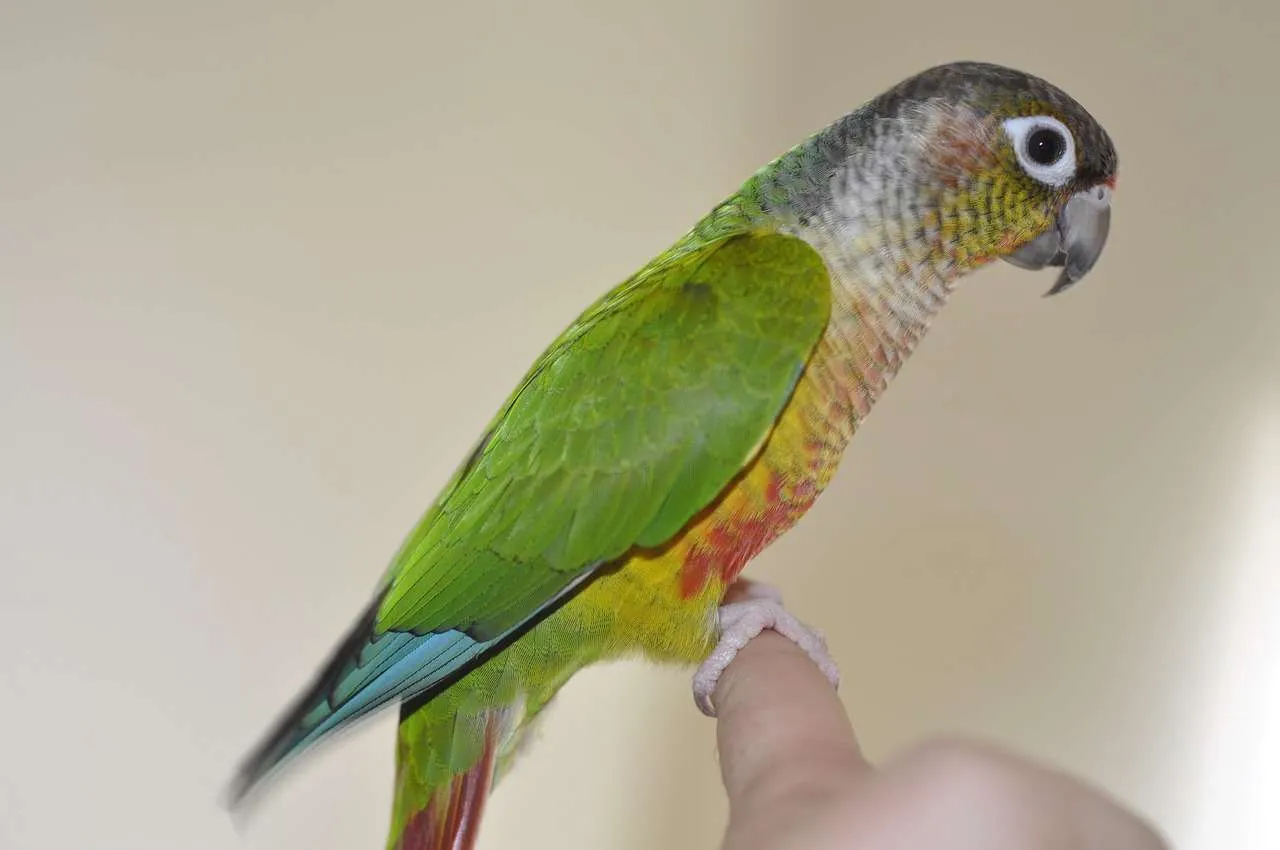Training
Birds do not respond to physical punishment well. If your bird does something you consider wrong, DO NOT HIT THE BIRD! Handfed babies are people-oriented, and the best kind of punishment for them is being removed from the presence of people for a short time. A loud “NO!” when you catch the bird biting, chewing something forbidden, or climbing off-limits areas, followed by a quick trip to its cage for ten to twenty minutes is adequate punishment. Keeping a smaller “jail” cage (a pet carrier will do) nearby is handy so you don’t have to walk all the way across the house every time you need to discipline the bird.
Most young baby birds do not know how to bite maliciously, but they will bite if afraid. They will also go through a phase known as “beaking”. During this time, they will try to bite and chew everything they encounter to see what is edible and what is chewable (conures are born with a need to chew things up). This is their way of learning about the world. Your bird will probably repeatedly attempt to chew your fingers. When it starts trying to chew them, tell it “No bite” in a quiet tone of voice. If it doesn’t stop, change your tone of voice to a slightly harsher one. If it starts chewing harder, blow a short, hard puff of air in its face, and say loudly “NO BITE!”. Also, quickly dropping the hand the bird is perched on (by just a couple inches) will put it off-balance and make it let go.
This idea of “causing an earthquake” is very effective in preventing biting– every time the bird tries to reach for you, give it an “earthquake”. It should soon associate cause and effect and stop trying to bite.
If the bird really does cause someone pain, a consistent course of action is required. What we do at our house is this: if the bird offends someone, that person is the one to discipline the bird and rush it to its cage to be locked up. That same person is the one to let it out at the end of the lockup time. Whatever you decide upon for “punishment”, you must be sure to respond the same way every time the bird does something undesirable or wishy-washy training will result in an unpredictable bird that can’t be trusted.
Don’t give up-the bird will eventually learn. This “beaking” phase usually lasts until the bird is about six to eight months old. The inborn need to destroy paper and wood, however, will last as long as the bird does, so never leave your parrot alone near anything you want to keep intact.
If you want to try to teach your bird to do tricks, you must first have a good day-to-day relationship with it. Let it learn to love you and get used to your home before you try to teach it anything.
Talking
I hope you don’t buy a bird JUST because you want a talking bird. Some birds will never speak. Love your bird for its sweet personality, and accept any talking it does as an extra gift. But there is no harm in trying to get it to speak. In my experience, parrots learn most from day-to-day conversations-repetition seem to bore them. I just try to say the same word or phrase when I do certain things, such as “Good morning” when I first greet them every day, and “I love you” when I cuddle them. My birds have learned more quickly that way than from any other method.
But repetition can’t hurt. If you want to try to teach your bird to talk, you must first decide on a simple word or phrase to start with. The bird’s name is a good starting point. Don’t expect the bird to clearly pronounce a word that contains letters that require lips to pronounce, like “B” or “P”-guess why! One person should be chosen as the voice teacher, as different voices teaching the same word will confuse the bird. Just sit near the cage, or hold the bird in front of you, and repeat the word every few seconds for about ten minutes. Do not attempt this if the bird has just been allowed out of the cage-an excited bird won’t pay any attention to learning anything.
Try speech training when nobody else is in the room to compete for the bird’s attention, and have all TVs and stereos off. Do this twice to three times every day, and at the end of each session, give the bird lots of praise and a treat, even if it doesn’t speak right away. Some birds will take years, and some learn quite fast. If the bird begins to attempt to mumble (most practice quietly before they say anything out loud), encourage it by repeating the word(s) for it. Don’t try to teach more than one word or phrase at a time, for this will only confuse it. Wait till you hear the bird say the word several times clearly at times other than “lesson time” before moving on to another word.
There are videos available that you can play to help teach your bird, some even made by other talking birds! Never teach your bird to say anything which others might find offensive. Remember, this bird could live a long time. Aside from being embarrassing in public, if the bird happens to outlive you, cursing and swearing might make it hard for the bird to get another home.
